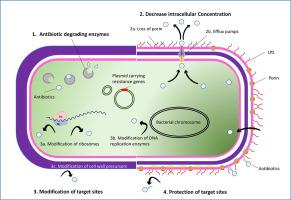Advanced Drug Delivery Reviews ( IF 15.2 ) Pub Date : 2021-12-09 , DOI: 10.1016/j.addr.2021.114078 Christopher K C Lai 1 , Rita W Y Ng 1 , Sharon S Y Leung 2 , Mamie Hui 1 , Margaret Ip 1

|
Antimicrobial resistance is a normal evolutionary process for microorganisms. Antibiotics exerted accelerated selective pressure that hasten bacterial resistance through mutation, and acquisition external genes. These genes often carry multiple antibiotic resistant determinants allowing the recipient microbe an instant “super-bug” status. The extent of Antimicrobial Resistance (AMR) has reached a level of global crisis, existing antimicrobials are no long effective in treating infections caused by AMR pathogens.
The great majority of clinically available antimicrobial agents are administered through oral and intra-venous routes. Overcoming antibacterial resistance by novel drug delivery approach offered new hopes, particularly in the treatment of AMR pathogens in sites less assessible through systemic circulation such as the lung and skin.
In the current review, we will revisit the mechanism and incidence of important AMR pathogens. Finally, we will discuss novel drug delivery approaches including novel local antibiotic delivery systems, hybrid antibiotics, and nanoparticle-based antibiotic delivery systems.
中文翻译:

通过新的药物输送方法克服抗生素耐药性的上升和演变机制——概述
抗菌素耐药性是微生物的正常进化过程。抗生素施加加速选择压力,通过突变加速细菌耐药性,并获得外部基因。这些基因通常携带多种抗生素抗性决定因素,使受体微生物立即处于“超级细菌”状态。抗菌素耐药性 (AMR) 的程度已达到全球危机的程度,现有的抗菌剂已不再有效治疗由 AMR 病原体引起的感染。
绝大多数临床可用的抗微生物剂通过口服和静脉内途径给药。通过新的药物递送方法克服抗菌素耐药性带来了新的希望,特别是在通过体循环难以评估的部位(如肺和皮肤)治疗 AMR 病原体。
在本次审查中,我们将重新审视重要的 AMR 病原体的机制和发病率。最后,我们将讨论新的药物递送方法,包括新的局部抗生素递送系统、混合抗生素和基于纳米粒子的抗生素递送系统。











































 京公网安备 11010802027423号
京公网安备 11010802027423号